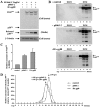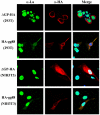The cellular protein La functions in enhancement of virus release through lipid rafts facilitated by murine leukemia virus glycosylated Gag
- PMID: 21343359
- PMCID: PMC3042739
- DOI: 10.1128/mBio.00341-10
The cellular protein La functions in enhancement of virus release through lipid rafts facilitated by murine leukemia virus glycosylated Gag
Abstract
Murine leukemia viruses (MuLVs) encode two forms of Gag polyprotein: the precursor for the viral core proteins (Pr65(gag) for Moloney MuLV [M-MuLV]) and a longer glycosylated form (glyco-gag, or gPr80(gag)). gPr80(gag) is translated from the same unspliced viral RNA as Pr65(gag), from an upstream in-frame CUG initiation codon. As a result, gPr80(gag) contains 88 unique N-terminal amino acids that include a signal peptide that conducts gPr80(gag) into the rough endoplasmic reticulum, where it is glycosylated, exported to the cell surface, and cleaved into two proteins of 55 and 40 kDa. The amino-terminal 55-kDa protein remains cell associated with the 88 unique amino acids exposed to the cytosol. We previously showed that gPr80(gag) facilitates efficient M-MuLV release through lipid rafts. In this report, we found that the unique N-terminal domain of gPr80(gag) is sufficient to facilitate enhanced M-MuLV particle release from transfected 293T cells. A search for cellular proteins involved in gPr80(gag) function led to cellular La protein. Overexpression of mouse or human La enhanced M-MuLV particle release in the absence of glyco-gag, and the released virus had a reduced buoyant density characteristic of increased cholesterol content. Moreover, small interfering RNA (siRNA) knockdown of human La abolished glyco-gag enhancement of M-MuLV release. These results implicate La as a cellular protein involved in M-MuLV glyco-gag function. We also found that overexpression of mouse or human La could enhance HIV-1 release in the absence of gPr80(gag). Therefore, M-MuLV and HIV-1 may share a pathway for release through lipid rafts involving La.
Copyright © 2011 Nitta et al.
Figures








Similar articles
-
Moloney murine leukemia virus glyco-gag facilitates xenotropic murine leukemia virus-related virus replication through human APOBEC3-independent mechanisms.Retrovirology. 2012 Jul 24;9:58. doi: 10.1186/1742-4690-9-58. Retrovirology. 2012. PMID: 22828015 Free PMC article.
-
Murine leukemia virus glycosylated Gag (gPr80gag) facilitates interferon-sensitive virus release through lipid rafts.Proc Natl Acad Sci U S A. 2010 Jan 19;107(3):1190-5. doi: 10.1073/pnas.0908660107. Epub 2009 Dec 28. Proc Natl Acad Sci U S A. 2010. PMID: 20080538 Free PMC article.
-
Mutation in the glycosylated gag protein of murine leukemia virus results in reduced in vivo infectivity and a novel defect in viral budding or release.J Virol. 2007 Apr;81(8):3685-92. doi: 10.1128/JVI.01538-06. Epub 2007 Jan 31. J Virol. 2007. PMID: 17267509 Free PMC article.
-
[Membrane Binding of Retroviral Gag Proteins].Uirusu. 2014;64(2):155-64. doi: 10.2222/jsv.64.155. Uirusu. 2014. PMID: 26437838 Review. Japanese.
-
Retroviral matrix and lipids, the intimate interaction.Retrovirology. 2011 Mar 7;8:15. doi: 10.1186/1742-4690-8-15. Retrovirology. 2011. PMID: 21385335 Free PMC article. Review.
Cited by
-
Murine leukemia viruses: objects and organisms.Adv Virol. 2011;2011:403419. doi: 10.1155/2011/403419. Epub 2011 Nov 15. Adv Virol. 2011. PMID: 22312342 Free PMC article.
-
Does Antigen Glycosylation Impact the HIV-Specific T Cell Immunity?Front Immunol. 2021 Jan 22;11:573928. doi: 10.3389/fimmu.2020.573928. eCollection 2020. Front Immunol. 2021. PMID: 33552045 Free PMC article.
-
Moloney murine leukemia virus glyco-gag facilitates xenotropic murine leukemia virus-related virus replication through human APOBEC3-independent mechanisms.Retrovirology. 2012 Jul 24;9:58. doi: 10.1186/1742-4690-9-58. Retrovirology. 2012. PMID: 22828015 Free PMC article.
-
Full-Length Glycosylated Gag of Murine Leukemia Virus Can Associate with the Viral Envelope as a Type I Integral Membrane Protein.J Virol. 2018 Feb 26;92(6):e01530-17. doi: 10.1128/JVI.01530-17. Print 2018 Mar 15. J Virol. 2018. PMID: 29298890 Free PMC article.
-
N-linked glycosylation protects gammaretroviruses against deamination by APOBEC3 proteins.J Virol. 2015 Feb;89(4):2342-57. doi: 10.1128/JVI.03330-14. Epub 2014 Dec 10. J Virol. 2015. PMID: 25505062 Free PMC article.
References
-
- Prats A. C., De Billy G., Wang P., Darlix J. L. 1989. CUG initiation codon used for the synthesis of a cell surface antigen coded by the murine leukemia virus. J. Mol. Biol. 205:363–372 - PubMed
Publication types
MeSH terms
Substances
Grants and funding
LinkOut - more resources
Full Text Sources
Other Literature Sources
Research Materials

